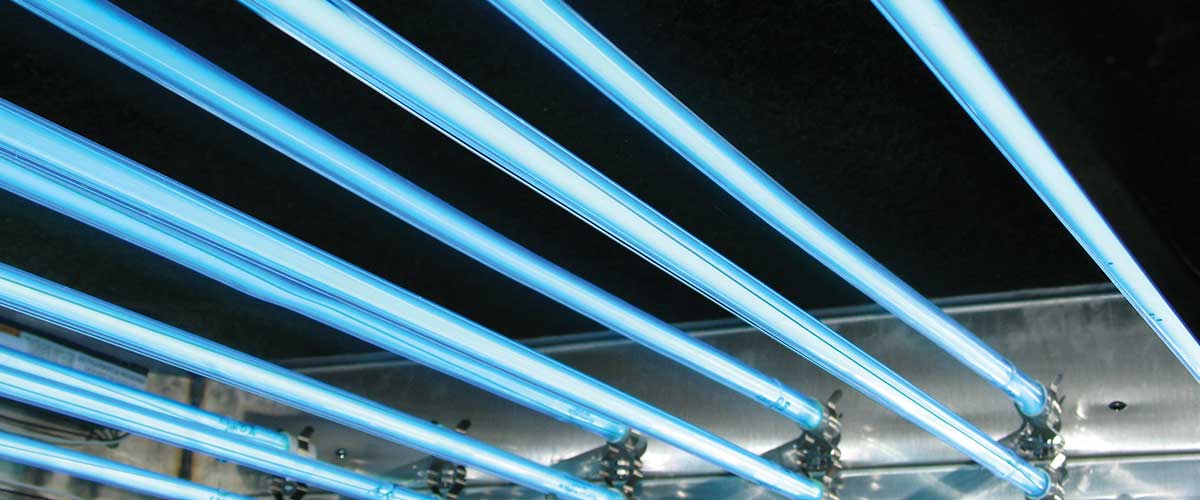Analysis: Target Levels of UVC Energy...
Each micro-organism has different traits or reactions to UVC in terms of the amount of energy (or exposure) needed to break down the nucleic acids. In order to effectively combat micro-organisms, one has to understand how target energy levels can be reached. In short, one has to balance the intensity of the UVC light source, the distance from the light source to the target surface, and the amount of time the target is exposed. For a listing of select microbes and their associated kill factors, click here.
GreenZapr - The GreenZapr® uses a total of sixteen (16) specifically designed UVC lamps. It’s designed to operate at a distance of 2.5” from the surface. At this distance, the energy intensity (measured in terms of micro watts per square centimeter) is 6,558 µW-s/cm². When operating the unit at the recommended 3-pass/6 mph method, the “dosage” is 6,707 µJ/cm² . For reference, Staphylococcus aureus (MRSA) requires 6,600µW/cm² for a 3-log (99.9%) reduction.
miniZapr - The miniZapr® has two different modules, the base unit and the hand-held. The base unit uses a total of eight (8) specifically designed UVC lamps and is designed to operate at a distance of 2” from the surface. At a standard walking speed of 2 mph and 3 passes, a dosage of 6,874 µJ/cm² is reached. The hand-held module relies on the operator to control all aspects of exposure (speed, distance, passes). At the basic use method of 2” at a speed of .5 feet per second and two passes, a dosage of 7,350 µJ/cm² is reached.
In order to understand the variables involved in exposure, the following tables are provided. In the simplest description — more time delivers higher dosages.
GreenZapr® - Calculations for Various Operational Speed/Passes for Energy Exposure
| Module/Cart Speed (mph) | 6 | 5 | 10 | 10 | 5 |
| Passes over field | 3 | 3 | 4 | 5 | 6 |
| Peak Exposure @ 2.5” (µW-s/cm²) | 6,558 | 7,672 | 3,836 | 3,836 | 7,652 |
| Total CALCULATED Dosage (µJ/cm²) | 6,707 | 9,416 | 3,139 | 3,923 | 18,831 |
miniZapr® - Base Module - Calculations for Various Operational Speed/Passes for Energy Exposure
| Module/Cart Speed (mph) | 2 | 1 | 2 | 1 |
| Passes over Surface | 3 | 3 | 2 | 2 |
| Peak Exposure @ 2.5” (µW-s/cm²) | 11,125 | 11,125 | 4,583 | 9,165 |
| Total CALCULATED Dosage (µJ/cm²) | 6,874 | 13,748 | 4,583 | 9,165 |
miniZapr® - Handheld Unit - Calculations for Various Operational Speed/Passes for Energy Exposure
| Module/Cart Speed (mph) | .5 | .5 | .5 | .5 |
| Passes over Surface | 2 | 3 | 2 | 3 |
| Peak Exposure @ 2” (µW-s/cm²) | 4,410 | 4,410 | 4,410 | 4,410 |
| Peak Exposure @ 3” (µW-s/cm²) | 2,940 | 2,940 | 2,940 | 2,940 |
| Total CALCULATED Dosage (µJ/cm²) | 4,900 | 7,350 | 7,350 | 11,025 |
NOTE: These operational methods are flexible and can be adjusted to meet the various needs or objectives of the user. Once these basic variables are understood, it is possible to develop the optimal method of UVGI treatment and continued schedule that effectively combats the microbes of greatest concern.
It is important to keep in mind that when operating any UVC equipment that more exposure/energy is better. In the case of the GreenZapr/miniZapr equipment, a more significant level of exposure is achieved in fractions of seconds. One should not get focused too precisely on any specific exposure number.
A more careful, deliberate approach to UVC equipment operation will result in greater certainty that any risk of infection by microbes has been reduced significantly.

